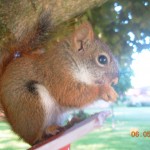Red Squirrels are Pine Squirrels
In the world of wildlife removal here in the Akron, Canton, Kent area, one particular critter that causes mischief in homes but is often overlooked is the red squirrel. One of the red squirrel’s other names is the pine squirrel. You’ll learn why in just a bit.
While not as prevalent as their gray counterparts, red squirrels possess distinctive characteristics and behaviors that set them apart. Join us as we discuss red squirrels this week. We will discuss their habits and offer some video examples of red squirrel investigations.
Identifying the Red Squirrel
Red squirrels (Tamiasciurus hudsonicus) are smaller in size compared to gray squirrels, measuring around 11 to 14 inches in length, including their bushy tails. As their name suggests, their fur is predominantly reddish-brown, though shades can vary from light brown to deep red.
Red squirrels are often associated with coniferous forests, particularly areas abundant in pine trees, hence their alternative name, pine squirrels. These agile creatures are expert climbers and are known for their acrobatic prowess as they navigate through the treetops with ease. Unlike gray squirrels, which are more adaptable to urban environments, red squirrels tend to prefer wooded areas with dense vegetation.
One of the notable habits of red squirrels is their preference for caching food. They hoard nuts, seeds, and cones in various locations within their territory, often burying them underground or hiding them in tree crevices. This behavior not only helps them survive during periods of scarcity but also inadvertently contributes to the dispersal of seeds, aiding in the regeneration of forests. Simply put, red squirrels are stockpilers of food. They gather their nuts of cones and store them in one or two large piles in their territory. Unlike a gray squirrel that buries nuts all over the place and then finds them later by smell, red squirrels keep all their food in caches.
Then when they go to eat, they always go back to the food pile and eat close by. They usually eat in the same place and all the discarded cones or nutshells accumulate in a pile as well.
When we are inspecting for red squirrels, we look for lots of nuts or pine cones in an attic. This is a hallmark of red squirrels. Also, we often find the pile of discarded food scraps as well. Finding one of these piles of debris is also a good indication of red squirrels.
While red squirrels generally prefer to remain in their natural habitat, they may occasionally venture into human dwellings in search of food or shelter, especially during harsh weather conditions. Their smaller size allows them to access narrower openings, making attics, crawl spaces, and eaves potential entry points into homes.
Experience with Red Squirrel Removal
 At Frontline Animal Removal, we understand the importance of promptly and effectively addressing wildlife intrusions, including those caused by red squirrels. We are well-versed in the behaviors and habits of various wildlife species, enabling us to accurately identify and resolve nuisance wildlife issues.
At Frontline Animal Removal, we understand the importance of promptly and effectively addressing wildlife intrusions, including those caused by red squirrels. We are well-versed in the behaviors and habits of various wildlife species, enabling us to accurately identify and resolve nuisance wildlife issues.
When dealing with red squirrel infestations, our approach involves a combination of humane removal techniques and preventative measures to ensure long-term solutions. By implementing exclusion methods, such as sealing entry points and implementing deterrents, we can prevent future incursions and safeguard your home against wildlife intrusion.
Here is a look at a recent red squirrel job. One of the takeaways is all the pine trees around this house. They are magnets for red squirrels and we are on alert when we see so many pine trees around.

Call Frontline Animal Removal for Red Squirrels
No matter what type of squirrel problem you have, Frontline Animal Removal is here to provide a solution.
While red squirrels may not be as common as their gray counterparts, their occasional presence in residential areas can pose challenges for homeowners. By understanding their habits and behaviors, as well as seeking assistance from wildlife removal experts like Frontline Animal Removal, homeowners can effectively mitigate the risks associated with red squirrel infestations.
Finally, here are some older videos of red squirrel inspections. They highlight a lot of the same information.
Check out these videos Ryan recently took during a couple of squirrel inspections. The signs definitely point to red squirrels.
In this video, did you notice the tree Ryan was moving in and around to show the entries on the front of the house? Yes, it was a pine tree of some kind. And lots and lots of walnuts up with the Christmas decorations…points to red squirrels.
In this next video, there is a great example of the debris pile created by a red squirrel when it eats. Called to do a squirrel inspection, this debris pile is a classic sign that red squirrels are the issue here.

